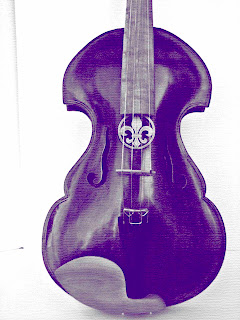String fabrication is an old technology! Herron-Allen tells us of sixteenth century makers following guidelines from Pythagoras! Musical preferences are also a consideration. Herron-Allen tells us that some players prefer a set of full diameter strings while some favor a set of thin diameter strings. He says nineteenth century players owned and used their own string-gauge. Strings must be "true". The diameter of each string must be uniform to achieve what twenty first century users call "harmonicity". Perfect "fifths" must be produced With our musical practice, we "learn" technique based upon string diameter and sound. We, likewise, benefit from ongoing manufacturing improvements! .
These web sites give a history of strings.
http://www.damianstrings.com/sh-faq.shtml
http://www.nrinstruments.demon.co.uk/hstvnst.html
Currently, strings are manufactured both in the USA and Europe with new entries from China. String making at the Dadarrio facility in Westchester county, NY, is covered by this video..
http://www.violinist.com/blog/laurie/20118/12542/
For most of us, the synthetic core vs steel core issue is a primary one. Individuals will favor synthetic (perlon) or steel core. The following video will help illuminate this issue. If you play two instruments, one might need perlon and another a steel core!
http://www.ehow.com/video_12225013_synthethic-vs-steel-core-violin-strings.html
Gut strings dominated the first 400 years of string manufacture and continue in use today! Rome was the center of this skill with fruitful efforts from Naples, Padua, and Saxony.. "Catgut" was the material of choice.
http://en.wikipedia.org/wiki/Catgut
You might consider the making of gut strings yourself! Details from old sources (Herron-Allen", are rendered faithfully present dayYouTube videos. Gut string making videos include
http://www.youtube.com/watch?v=k1aYaHEl9Rg&feature=related
How can you best outfit your instrument? Replace your strings as recommended. Listen to your strings. Ask knowledgeable players to listen. Ask for their string selection advise. Viola, cello, and bass users will give different responses; learn from these also. Carefully read the web site information for several violin string vendors. Look for specific sound effects and imperfections you might have noted in your violin. Search for and implement string selection changes. Keep a log of your work. Compare perlon (synthetic) to steel core. Your violin and your musical needs will prefer one over the other!
Finally measure your string clearance. At the fingerboard end, the E clearance is 3.0 mm and the G is 5.5 mm. At the nut, both are 0.3 mm. A higher setting might affect sensitive fingers and artist proficiency. (A USA dime is 1 mm, a penny 1.4 mm, and a nickel is 1.8 mm.) Combine this attention to an optimization of sound post position. Monitor the post location. Seek repair if it moves. (Winter to summer and vice versa climate swings might affect this position.)
Enjoy your playing and enjoy the benefits of your improved string knowledge and sophistication.







No comments:
Post a Comment